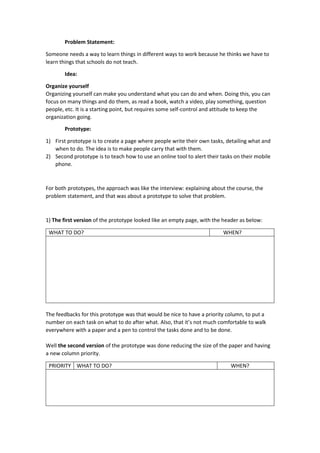
Organize Yourself With Tasks And Reminders
- 1. Problem Statement: Someone needs a way to learn things in different ways to work because he thinks we have to learn things that schools do not teach. Idea: Organize yourself Organizing yourself can make you understand what you can do and when. Doing this, you can focus on many things and do them, as read a book, watch a video, play something, question people, etc. It is a starting point, but requires some self-control and attitude to keep the organization going. Prototype: 1) First prototype is to create a page where people write their own tasks, detailing what and when to do. The idea is to make people carry that with them. 2) Second prototype is to teach how to use an online tool to alert their tasks on their mobile phone. For both prototypes, the approach was like the interview: explaining about the course, the problem statement, and that was about a prototype to solve that problem. 1) The first version of the prototype looked like an empty page, with the header as below: WHAT TO DO? WHEN? The feedbacks for this prototype was that would be nice to have a priority column, to put a number on each task on what to do after what. Also, that it’s not much comfortable to walk everywhere with a paper and a pen to control the tasks done and to be done. Well the second version of the prototype was done reducing the size of the paper and having a new column priority. PRIORITY WHAT TO DO? WHEN?
- 2. After this, the feedback was only about carrying it everywhere, with a pen to take notes. But ok (probably by the face it won’t be used). What would I do next, continuing working on this, was trying a size of paper that can fit on a wallet, and find a small pen that can be put on your pocket as a mobile phone. 2) For the test with the second prototype, I used Google Calendar. I taught on how to set the mobile number to be notified about a task, and how to insert the tasks on that application. Well, the first question was about accessing the application to manage the tasks, followed by the question about receiving a message for every task, how could you set that the task was realized. That was before using. The feedback after use was about failing on tasks, because the user did not pay attention to the messages received (kept on his pocket). What would I do next, continuing working on this, was putting a bracelet (just a strip) that make the person realize that she should look at the mobile to check tasks.